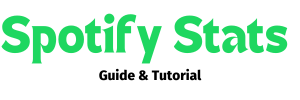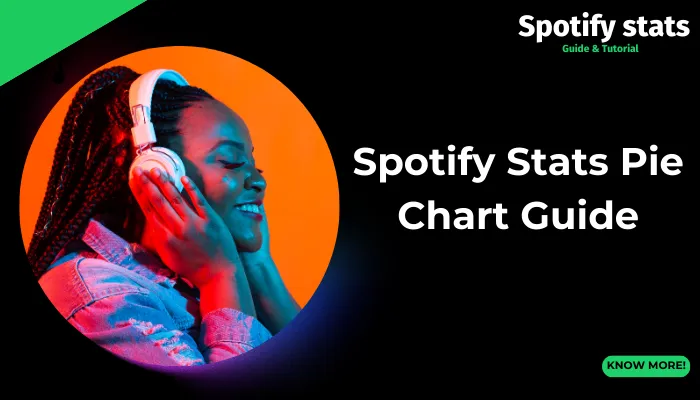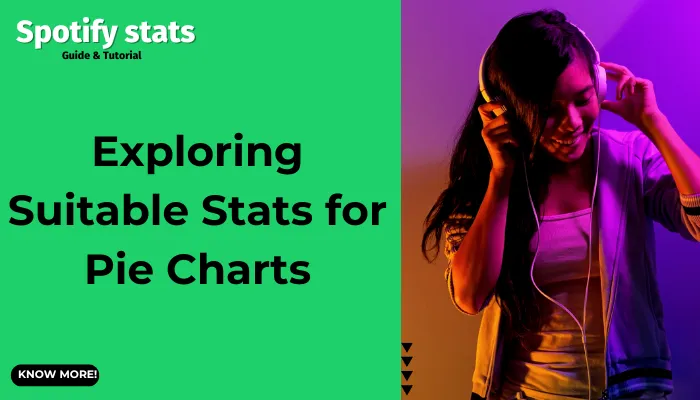The Spotify Stats Pie Chart is your answer to every question relating to music stats. For data lovers, curious onlookers or passionate listeners, these charts help you highlight and understand your music preferences in a visually appealing manner.

What if I told you that a simple pie chart could reveal your favourite artists and top genres as well as break down your listening habits into easily digestible bits? Not just any numbers but figures that tell the story of your musical side. Enter Pie Chart and discover the soundtrack to your life like never before.

Spotify Stats Pie Chart Guide
Consider it this way; every song played, artist discovered, or genre explored forms part of an individual’s musical fingerprint. This is carefully tracked by Spotify which then unveils intriguing insights into one’s sound choices. These statistics can inform on:
- Your Top Artists: Who are the musical maestros that dominate your listening experience?
- Genre Breakdown: Does your pie chart lean towards the pulsating beats of Pop or the soulful melodies of R&B?
- Hidden Gems: Those lesser-known artists who really get to you but that you have never told anyone about before now.
- Evolution of Taste: Observe how your music tastes have altered over time. Did you love rock during high school but now sway gently to mellow acoustic tunes?
These are gems for any music lover. But numbers and percentages can become too much for anyone. Now is when Spotify stats pie chart work magic!
Power Behind Spotify Stats Pie Chart
A pie chart converts raw data from Spotify into a visually stunning masterpiece. Each slice of the pie represents different genres, artists, or even songs (depending on how detailed you want to be). By using this format, finding out why one listens to certain types of music becomes easy, brief, and oh-so-shareable.
The reason why pie charts rule with regard to Spotify stats is as follows:
- Instant Insights: You need only look at the pie and you’ll know right away what your predominant genres are or who your favorite artists are. Forget about finding meaning in complex charts or going through numbers for hours.
- Comparison is Key: Encourage healthy competition or share your special pie with friends who love music. Pie charts make it simple to compare and contrast listening habits, leading to fun discussions about musical preferences.
- Social Media Savvy: Pie charts are intrinsically aesthetically pleasing and this makes them perfect for social media. Imagine how many likes you would get from your followers when they catch a glimpse of your diverse, maybe focused musical identity!
So the next time you feel like knowing your Spotify stats don’t bother with tables; go for the pie-chart. It’s a fun way to dig into the music that is in your soul as well as celebrating the soundtrack of your life!
Crafting Your Pie: A Step-by-Step Guide
Ready to ditch the mystery and see your Spotify listening habits laid bare? This section will show you how to create your own Spotify Stats Pie Chart, transforming cryptic data into a colourful masterpiece. It’s easier than you think, so grab your data and get ready to bake up some musical self-discovery!
1. Gather Your Musical Arsenal:
The first step involves gathering the important data about you on Spotify. Unlocking this goldmine of listening can be done in several ways:
- Head to Spotify Stats: This hidden treasure can be found through third-party websites or services which will securely log into your account and then collect all information about what you listen to. Some popular examples include Stats.fm, Spotistats, and even Facebook along with others on social media platforms which integrate with Spotify to generate insights.
2. Choose Your Weapon of Choice:
Time has come for picking up one particular pie-charting tool over another. There are several options available each having its pros and cons:
- Spreadsheet Software (Excel, Google Sheets): These reliable workhorses suit those who feel comfortable working with data files where further customization is required though this demands some technical know-how.
- Online Charting Tools (Canva, ChartGo): These online warriors are ideal for beginners. They offer user-friendly interfaces with pre-built templates that you can use to make beautiful pie charts easily and quickly. However, their customization options may sometimes be limited if compared to spreadsheets.
3. Data Input:
After acquiring your data and tool, it is time for some hands-on experience (metaphorically speaking). Though there are variations depending on the choice of the tool, here is an overview:
- Import Your Data: For spreadsheets one may need to manually enter this data from Spotify Stats. Online tools provide direct import options most times.
- Choose Your Slice Size: Do you want each slice to represent a genre or artist, or maybe even individual songs?
- Label Your Slices: Make sure you clearly label every pie piece with the name of artist, genre, or song.
- Color Coordination: To make your pie more interesting add some color! Choose colors which express the mood of a particular genre or artist.
4. Customization Corner:
And now let us have some fun! You can personalize your pie chart using many tools:
- Add a Title: Give your pie chart a catchy title that reflects your musical identity.
- Play with Fonts: Opt for fonts typefaces that are easy to read and match the general look and feel.
- Beat in the Background (Optional): A number of online tools can enable you to add a background image that compliments your taste in music.
Now sit back, appreciate what you’ve done & tell everyone about your Spotify Stats Pie Chart story!
Tool Options To Craft Your Pie
The right tool can make all the difference when it comes to building your Spotify Stats Pie Chart. Here is a breakdown of some popular options, along with their advantages and disadvantages:
| Tool | Benefits | Disadvantages |
|---|---|---|
| MS Excel | High degree of customization, allows for intricate manipulation of data | Requires technical knowhow, could be time-consuming for visually appealing charts creation |
| Google Sheets | Free software, easy to use, good for collaboration purposes | Fewer customization features compared to Excel |
| Online Charting Tools (Canva, ChartGo) | Ease of use, pre-built templates available and nice-looking options | Limited customization than spreadsheets do; may require payment to access advanced features |
In the end, the most suitable tool will depend on your level of comfort and how much you want it customized. So go wild! Go exploring! And find just the perfect fit for this pie-charting journey of yours!
Now that you know how to create your Spotify Stats Pie Chart; why don’t we dive into data visualization? There’s a lot more beneath the surface if we look at our listening habits closely enough.

Exploring Suitable Stats for Pie Charts
Now that you know how to create your Spotify Stats Pie Chart; why don’t we dive into data visualization? There’s a lot more beneath the surface if we look at our listening habits closely enough.
Not all stats on Spotify are equal. Some are best represented as pie charts while others might work better with bar graphs or time series. Here is a breakdown of some data points that shine in the pie chart spotlight:
A. Prime Pie Chart Material:
- Listener Demographics: Unveil the age range, location, and even gender of your fellow listeners for your favorite playlists (if this data is provided by the tool you’re using).
- Genre Distribution: Find out which genres prevail in your musical preferences. Is your pie chart a colorful mix of Pop, Rock, and Indie or do you stick to one genre only?
- Playlist Popularity: Do you sometimes wonder which of your curated playlists resonates most with your fans? By representing the popularity breakdown of these playlists through a pie chart, it will help understand how much impact you are making as a tastemaker.
B. Not So Pie Friendly Stats:
- Track Performance: Although technically possible to come up with a pie chart for each song within a playlist, it might get cluttered and hard to interpret. Instead, bar graphs could be used to compare play counts of favorite tracks.
- Listening History Over Time: This can be visualized best using line graphs or heatmaps that show how your musical tastes have changed over months or years.
And while doing this ensure that you choose data items that can be easily segmented into well-defined groups; making it highly informative and visually appealing all at once.
Insights from Your Spotify Stats Pie Chart
Well, you have got your Spotify Stats Pie Chart in all its colorful glory. But what does it all mean? Here’s how to unlock the hidden musical messages within your pie:
Understanding the Segments:
- Size Matters: The bigger the slice, the more dominant that genre, artist or playlist is in your listening patterns.
- Slice & Compare: See how your pie chart matches up with friends’ to find out if your musical tastes are similar or different.
- Unexpected Gems: Was a small slice something you did not expect? Maybe you should revisit that artist whom you loved but haven’t listened to for some time now.
Drawing Actionable Insights:
- Discover New Tunes: If one kind of music is overwhelmingly represented on your pie chart, listen to similar musicians or explore deeper into subgenres.
- Curate with Confidence: Use information from the graph about music preferences to adjust playlists according to mood and activity.
- Challenge Yourself: Feeling one-dimensional? Use this as a stepping stone toward new genres and artists outside of your comfort zone.
The Spotify Stats Pie Chart provides an in-depth understanding of who you are musically. Allow it to take you on an amazing adventure into self-exploration and discover all of the sounds that shape your unique personality!
Frequently Asked Questions (FAQs)
We’ve explored the wonderful world of Spotify Stats Pie Charts, from crafting your first masterpiece to unlocking the hidden insights within your musical data. Now, let’s tie it all together and answer some burning questions you might have.
Q. What is a Spotify Stats Pie Chart?
Spotify Stats Pie Chart is a visual representation of your listening habits on Spotify. It breaks down your music preferences into various categories such as genres, artists, and tracks, displaying each as a slice of a pie chart.
Q. Are these third-party tools safe to use?
Yes, reputable third-party tools like Stats.fm and Spotistats are safe to use. They securely connect to your Spotify account to extract your listening data without compromising your account’s security.
Q. Can I share my Spotify Stats Pie Chart on social media?
Indeed pie charts are good for social media shares because of their lovely outlook. Many charting software allows you to save your chart as an image file so that you can publish it on any number of popular social networking sites.
Q. Is it possible to create a pie chart for my entire listening history on Spotify?
Yes! it is possible to generate a pie chart for all the songs you have listened to. Alternatively, if your data set is large and contains more records, you can break it down into shorter time periods like monthly or annually so as to make it easier for analysis.
Conclusion
The Spotify Stats Pie Chart offers a fresh, vivid way to understand the melodies which form the background score for our lives. From genre breakdowns to top artists, these pie charts shed light on what makes our ears happy, helping us see patterns we’d otherwise overlook.
And now the time has come for you to make this pie and tell everyone about it! Perhaps you’ll discover something surprising about your tastes, or possibly inspire someone else to dig deeper into their listening habits. So go ahead; let the music speak through the power of pie!
